Philip C. Barragan II's Blog: Embonpoint Publishing
May 31, 2019
Graphic Novel Updates
It’s been two years since Mason and I established our indie small press, Embonpoint Publishing. And in that time, we have published four graphic novels for our two titles, Fatizen and Blanc Noir. We’ve enjoyed the work, and have been lucky to work in collaboration with three other fine graphic artists, Caleb Halstead, Robert Bulanadi and Chris Link.
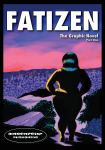



This is a complete labor of love. The work of small press is endless, and quite the education. We’ve been blessed with a dedicated following, and we’re thankful for those who have supported us.
Our latest issue of the Marabou Mule Mystery Series, Blanc Noir Ferox came out a few weeks ago. This is has been a year in the making. It’s our ghost story. It was a blast to create and send our heroine into a haunted house and solve the mystery at hand. We hope you get the chance to enjoy it. You can order it from us directly, your local bookstore or on Amazon or at Comixology for you digital consumers. If you’d like to see our 60 second book trailers, check them out here.
We’re busily working on Part Two of Fatizen. That should be out by December 2019. Mason is nearly finished with illustrating Part Three, but our focus is on the coloring and lettering of the next issue.
Somewhere in all of this, Philip is also working on edits for a second edition of Fatizen 24602, the prose version of the Fatizen saga as well as a book of nonfiction essays.
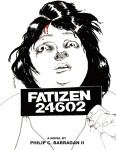
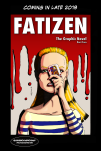
One of the most interesting aspects of adapting a graphic novel from a prose novel is deciding what elements remain in the final “cut.” I imagine it’s much like the process of a movie adaptation. Not every word or conversation or character can go into the graphic novel. And not every bit of dialogue makes it either. That is the toughest part for me as I letter the pages. What have I learned, specifically? I overwrite. And having to choose what is essential and will move the story forward has been a fantastic lesson in using an economy of words. It has made me a better writer. And editing is writing, as a friend and mentor once told me.
What is this about our t-shirts you ask? We have put two styles available for $20.00 each. The fabulous Marabou Mule and the other is a male bodybuilder (modeled by our friend Vince) in a Bettie Page pose. They’re available from our website (including big sizes), or at Made by Millworks on Pine Avenue in downtown Long Beach (who also carries our books).

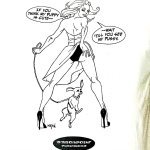
If you have any questions or comments about our titles, we’d love to hear from you. And stop by our website, http://www.embonpointpublishing.com. Thank you!
June 9, 2016
When words get in the way
 The Queen Mary (the original)
The Queen Mary (the original)June has arrived and I’ve just started the first day of my vacation. The husband and I are checking into the Queen Mary Hotel tomorrow for a thrilling stationary weekend voyage in Long Beach Harbor. Ghost hunting will definitely be on the agenda as well as dining and grand buffets. However, I’ll be spending much of the time working on lettering our graphic novel. It’s been the primary project we’ve been working on for the past few years-alongside the prose novel, Fatizen 24602.
For those of you who don’t know, my artist husband, Mason Arrigo, wanted to turn my book into a graphic novel. And so he has been working on it full-time for the past several years. We have been blessed to find two colorists, Sean Lake and Chris Link, to take Mason’s illustrations and turn them into some pretty fantastic colored pages.
 Delilah meets the Serena 900 hologram in Fatizen-The Graphic Novel. Illustration by Mason Arrigo, coloring by Chris Link.
Delilah meets the Serena 900 hologram in Fatizen-The Graphic Novel. Illustration by Mason Arrigo, coloring by Chris Link.I’ve become more adept with Adobe Illustrator and Photoshop over the past few years-skills I never anticipated I’d require or need. But this process has fulfilled that graphic artist part of myself that I’ve not explored in a long time. It’s been a lot of work, but enjoyably so.
Learning how to create a graphic novel from a prose novel has been an education, and not something to take lightly. The task of adaptation is tough-not every word, thought or action is going to make it in the final product. I suppose it’s not unlike a screenplay adaptation, but that’s just an educated guess. The final choices come down to what pushes the story forward, what’s fluff, and what is absolutely essential. A lot of the dialogue has to be edited down to the bare essentials. All while I’m screaming on the inside.
 Delilah escapes the Dietary Guard Patrol in Fatizen-The Graphic Novel. Illustration by Mason Arrigo, coloring by Sean Lake.
Delilah escapes the Dietary Guard Patrol in Fatizen-The Graphic Novel. Illustration by Mason Arrigo, coloring by Sean Lake.As we approach completion of the first of three books (the graphic novel is broken into three different sections), I’m reviewing all of our finished pages. It’s been a lot of work, and there is much to check. Selecting and placing the word balloons on the page is one my tasks, and it’s only now that I realize how this process has been good for my writing.
Each day is spent reviewing my original manuscript to select the words for the pages. I I have to admit that some days I’ve felt a bit ‘stuck’ in this world I created. As much as I love my characters, sometimes parents need a break from their children, right? But in this review process, I’ve learned that I could have edited my original manuscript down. Significantly. I suppose as writers, we all look at our work and we can continually revise our words without end. Some of us may be more inclined towards the poetic while others naturally lean towards the verbose.
 Delilah’s arrest in Fatizen-The Graphic Novel. Illustration by Mason Arrigo, coloring by Chris Link.
Delilah’s arrest in Fatizen-The Graphic Novel. Illustration by Mason Arrigo, coloring by Chris Link.I suppose it’s odd for a writer to say that the words got in the way of telling a story. So I won’t say it, or even suggest that was an issue for me. But I love that even in the process of working on this amazing project, I’ve added to my writerly toolbox. Any project that builds your skill set is worthwhile, especially when it comes to telling your own story. And getting to work on a project with some talented graphic artists (friends and my own husband) is certainly time well spent.
Next up-to find an agent who works with graphic novels. But for now, full steam ahead-and bon voyage to us!
Keep on writing!


March 5, 2016
Creating a New Marketing Plan
How many authors have experienced the fear that no one wants to buy your book? It’s not unusual, based on the number of my peers who have said as much. But it’s tough to get negative thoughts out of your head, those lingering toxic emotions, whispering sweet apprehensions and self-doubts causing nothing but anxiety and dreadful imaginary scenarios that just don’t exist. Fear can be paralyzing, and it can keep a writer from sharing their talent with the world.
I’ve relied on Amazon as my primary source of book sales. But without a big marketing budget, it’s been moderately successful but nothing like I’d like. I did follow-up with a very nice woman who reached out to me following my review in Publisher’s Weekly. She was from New York and quoted me her standard fee of $5,000 per month, and that didn’t include the actual cost to place ads, etc. I thought about it for a few minutes, looked at my checkbook, and wrote back stating I couldn’t afford her services. She gave me a freebie and told me to get it into Rebel Wilson’s hands. That seems easier said than done, but I’m still working on that one.
Last night I received an email from a local store that sells books and crafts from local residents called Made in Long Beach. My husband Mason found them on Pine Avenue in the former Crate and Barrel storefront and they put my book on the shelf. The email stated they had sold out of all copies and wanted more. And it made me think…every one of the three stores I’ve worked with, Gatsby Books, BookShow and Made in Long Beach, have sold out of Fatizen 24602. And some stores more than once. So why not go far and wide?
I had several discussions with friends about how to get a book out in the world. Without a big publishing company behind you, indie authors (or those working with small presses) have to take time and money into consideration. FaceBook is limited in the audience it can reach unless you pay for it, which is fine and annoying at the same time. I’ve paid for distribution of a few posts without much success from my book’s page. I admit that I had a lot going on last year, the first year of my book’s release, the biggest of which was purchasing our first home a few months after the book’s release. But no real excuses. Life is busy and we need to prioritize.
I’ve had time to refocus, and I will be putting together a new marketing plan to get my novel into small, independent bookstores. It’s doing well when it’s on the shelf. Maybe it’s my husband’s artwork on the cover and sprinkled throughout the book, but whatever the draw is, I have to get into the hands of potential readers. That’s where it’s selling.
I did put together an initial plan to get the book into bookstores nationwide, but when I encountered barriers locally, I stopped with that plan. What I didn’t know then was how to approach independent bookstores. Some are a bit over particular about what they want not their shelves, and I suppose it’s their right. This end of the business isn’t as easy as I thought it would be, but I’m mastering my approach.
If you have a favorite independent bookstore in your neighborhood, send me their contact information. I’d like to get my book into as many as I can. Thanks, and be well!


December 6, 2015
The Have and Have Nots?
My response to an article at Literary Hub called, “HOW THE LITERARY CLASS SYSTEM IS IMPOVERISHING LITERATURE-ON THE SYSTEMIC ECONOMIC BARRIERS TO BEING A WRITER.” Writer Lorraine Berry discusses her views on MFA degrees as a (possible) form of elitist class privilege:
Interesting article. It did make we wonder if the discussion has to be so (seemingly) black and white. I know of many writers with MFAs who have worked hard at their craft while working two and three jobs to pay for grad school.
While I agree your colleague’s comment shows a narrow view of what makes a writer worthwhile, not all individuals with MFAs come from that Sontag class of privilege. I envied those individuals in my MFA program who didn’t have to work full-time. And I didn’t have the luxury to finish my book by writing all day like Flannery O’Connor did either.
I had to get up at 4 AM to write before going in to work, write on my lunch breaks, and after getting home from a ten hour day to get my first novel published from a small press. All without an agent.
Nothing in my experience has been easy, and I hope I never feel like I have to apologize for working so hard to get my MFA.
I know many fine writers without one who share similar experiences with the ups and downs of the writing life, but I feel there is more common ground than looking at this as the have and the have nots.


December 4, 2015
Plotting, Planning, and traveling back in Time
It’s not always easy to look back and evaluate your work with a critical eye. But it’s healthy, necessary, and motivating when you realize that you’ve acquired the skill set to see the areas that need work. And in review, some of those areas seem rather alarming and you wonder how that sentence or paragraph got past you and your editor. Ultimately, you have to accept that fact that your cake has been baked, iced and served leaving nothing but crumbs to be read like scattered tea leaves on the bottom of the plate.
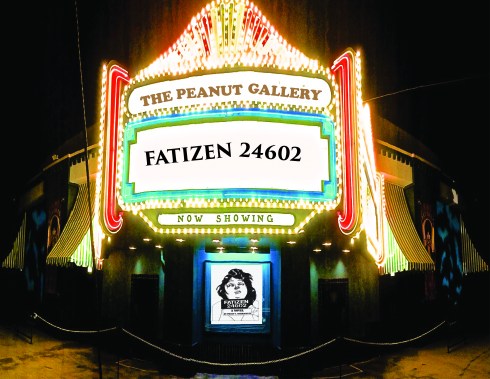
For me, the past twelve months have been one of the most intense, life-altering years, ever. I got married, published my first book and purchased my first home. I am lucky to be surrounded by a phenomenal group of family and friends (including my outstanding spouse) that have supported me through this mind-expanding journey.
Fatizen 24602 has been my sole writing passion for such a long time now. I’d almost be naked without it. (Yeah, go ahead an imagine that.) I am a fat activist, and always have been. I started a group for gay fat men in 1996 with a friend of mine called Girth and Mirth Long Beach to address the needs and social welfare of the fat gay man (and bears). The group ran for over ten years and it was a raging success due to the men who ran it and the dedicated members who wanted a safe place to meet others.
Since that time, I’ve wanted to contribute, somehow, to the national discussion of fat in our society, especially now with all of the fat shaming to be found in social media. I am hoping that the upcoming graphic novel of Fatizen will help get the story out to a wider audience and address these issues for younger readers as well. My husband, Mason Arrigo, is working diligently on the artwork and fleshing out Delilah’s story in beautiful illustrations. It’s exciting to see the project continue and evolve. There is more story to come with Delilah, Rhonda, Mark and Rick. And who knows what may follow on the larger screen: lots of plus-sized possibilities.
I get people contacting me every week who have found their way to the book though one of the book’s platforms on the web. The word is spreading, and that’s a fabulous thing.
Now that the book is out and circulating around the room like a little Patrick Dennis in Auntie Mame, my thoughts have returned to the ongoing family research I’ve been conducting for my upcoming writing project about the women in my family: my mother Mary Martha, my Grandma Nina, her mother Maria, and my great great grandmother Petra going back to 19th century Mexico. The working title is The Things my Mother Told Me. It’s a family memoir woven within the history of the Mexican Revolution-a piece of history that a lot of people don’t know about. I’m looking forward to returning to Mexico for further research.
I’ve resumed speaking with the women in my family and I’m digging out the tape recordings I made from my Great Grandmother Maria before she died in 1991. This is a real labor of love, and I have to admit it’ll be a nice break from fiction. I just hope my Spanish isn’t as rusty as I think it is. And please, don’t test me.


October 10, 2015
Why I write
This week I experienced a momentary existential crisis. I was surrounded by those self-doubts that we all have, and that we keep in check by locking them in that closet under the stairs with those monsters of childhood and demons of adolescence. I ignored the shrieks of terror and the pounding on the door shaking the house with those tepid sounds only heard in the most common of nightmares.
It really wasn’t that bad, but it was a tough week. After months of waiting, I finally received a review from Publisher’s Weekly. I knew it could go either way, but I didn’t anticipate the reviewer tearing my work to shreds. All of the workshopping I did in the MFA program almost prepared me for this unforgiving review. The review began by describing Fatizen 24602 as, “saddled with the unsubtlety and logical complexity of Ayn Rand.” Of all people to use as a comparison. (My friend Daphne said it best, “them’s fightin’ words!”) But with each gnawing sentence of this unrelenting review, my heart sank a little deeper until the critic added, “…uncompelling and unoriginal.” Their pen was a scalpel slicing with unabating fury.
Now I stare at the nearly lifeless body of the middle of my living room. She’d been such a source of enjoyment for so many years. Her name was Delilah, and she was my virtual companion and more than a storyline. But now she lay in a pool of blood, “a character who was barely realized.” Really?
It’s only one reviewer’s thoughts, but it was disappointing. In working on the upcoming graphic novel of the book, there are moments when I’ve wanted to rewrite a passage or three and make it better-the pros and cons of working on your craft. I love seeing Mason’s illustrations of how he sees my world and the characters I’ve created. And like any parent, praise them all you want but I don’t want to hear negative crap about my kids.
I write because there are stories inside that I have to let out. There are new characters screaming to be heard and plots needing to be birthed or my mind will be a constipated mess. I went to school so I could learn how to do this right. I’ve been taught by some great and talented writers. So no, I’m not afraid of a bad review. It’s clear that this critic really didn’t like my book. Passionately. He/she didn’t like where I went with it and what I focused on. The topic is controversial and everyone brings his or her own baggage along for the ride which informs their own read.
I also write because I love it and the process of learning. As writers, we lay it on the line in words, beautiful words that, when done right, float off the page and create beautiful or terrifying worlds or impart insightful memories of our lives that are worthy of sharing with others. And then we have to let go and move on to new projects.
It’s a brave thing to put your writing out there for others to critique, and it’s not always easy. Critics won’t always be nice, aren’t always understanding and won’t always share your point of view. And most importantly, they didn’t all get the memo to “not be an asshole.” But there are more stories for me to tell. So this fat boy is dusting himself off, nursing his bruises, sharpening his writing teeth, and applying Jungle Red fingernail polish because I’m so not done here.


September 7, 2015
Changing the things I cannot accept
“I am no longer accepting the things I cannot change. I am changing the things I cannot accept.” ~Dr. Angela Davis
I posted this quote on my FaceBook page and it spurred a discussion about making change in the world. Angela Davis played on the language of the Serenity Prayer to make her poignant point, and it worked. When someone close to me responded with, “Good luck with that,” it made me wonder if they missed the point.
Years ago, my uncle, a police detective, asked me if I was a bleeding heart. I was in the seminary at the time and I took it as a compliment, though it really wasn’t. As much as I wanted to be an instrument of change as a young seminarian, I hadn’t really experienced much hardship in life.
Soon after leaving the seminary, I met a guy named Gary Dowd. I just turned 23. Gary was a spectacular, enlightened, learned individual. He was a passionate high school English teacher, and he baptized me into the world of activism. Not long after renting a room from him in the El Sereno neighborhood of Los Angeles, I tested HIV positive. I didn’t know what to do or who to talk to. Gary grabbed me by the hand and said, “Come with me.” He was HIV positive as was the third member of the household. I had landed in the most supportive place possible. Gary took me to my first AIDS Coalition to Unleash Power (ACT UP) meeting and introduced me to a group dynamic men and women.
ACT UP did a lo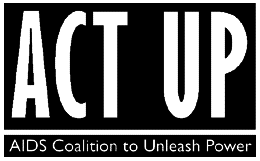 t of joint activities with the L.A. Chapter of the National Organization for Women. We helped women get into clinics and past the “Operation Rescue” crowd blocking the entrance with their rosaries and prayers. We stopped the Rose Parade in 1990 for about a minute by sitting down across the street chained together. We also stood up and walked out of midnight mass that Christmas in Saint Vibiana’s Cathedral in Downtown LA in protest of the Catholic Church’s position on condom use related to disease transmission. I saw familiar faces at every turn from my former seminary days, but what was difficult for me to assimilate was the anger that I found with my fellow ACT UP brethren.
t of joint activities with the L.A. Chapter of the National Organization for Women. We helped women get into clinics and past the “Operation Rescue” crowd blocking the entrance with their rosaries and prayers. We stopped the Rose Parade in 1990 for about a minute by sitting down across the street chained together. We also stood up and walked out of midnight mass that Christmas in Saint Vibiana’s Cathedral in Downtown LA in protest of the Catholic Church’s position on condom use related to disease transmission. I saw familiar faces at every turn from my former seminary days, but what was difficult for me to assimilate was the anger that I found with my fellow ACT UP brethren.
All of the members of this group expressed such deep felt anger, and I couldn’t find that within myself. Their anger came from the Catholic Church’s slow-moving position on HIV/AIDS (transmission prevention) including groups like Operation Rescue, and the federal government’s refusal to pass legislation on HIV/AIDS funding. Spending time with these remarkable individuals and listening to their stories helped me to see why it was necessary to fight for what was right.
I remember Gary crying one day out of frustration. He went to one of the three locations in Los Angeles where everyone with HIV/AIDS had to go to get their AZT (antiretrovirals to halt the progression of HIV). The pharmacy clerk said he couldn’t pick up his drugs due to some glitch. And that’s when he started screaming, “I need my fucking medications to live! Give me my god dammed drugs!” and she did.
I held Gary close, and it was then that I realized I had to fight to effect change. No one was going to do a thing if we didn’t yell, scream and commit more acts of civil disobedience. We had to get “in the way” and make ourselves heard. Within a year, in 1990, and with the help of an Indiana mother and her brave son with AIDS, the Ryan White CARE Act was signed into law. This was the much-needed HIV/AIDS funding legislation that our country needed to provide care and services, including medications, to individuals living with and affected by HIV/AIDS.
I am changing the things I cannot accept. I not only hear these words, I embrace them. Angela Davis was speaking to the fight for civil rights, but I’ve seen change in action. I’ve stared into the face of adversity screaming at me with self-righteous religiosity from the holiest of people. We don’t have to accept things the way they are just because that’s how they’ve always been.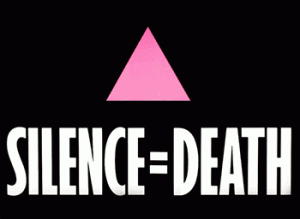
I was told that the life expectancy of someone living with HIV/AIDS was ten years. We’ve learned a lot since 1989, but I never expected to see my 30th birthday, not to mention 40. I’m ecstatic about turning 50 next July. I’m sorry that Gary isn’t here to share that celebration, but he opened my eyes and heart to the need for change in the world. For that gift, I am forever grateful.


September 2, 2015
Managing Critical Reviews
I knew that there would be readers of my book that didn’t share my point of view on fat. That was a given. I wrote my novel to share my thoughts on fat, equality and the right to choose to live any way that you want to regardless of your body size. And I’ve been working to get my book reviewed by more notable sites which is no easy task without an agent or good contacts. I’ve been wondering if the subject matter is a turn off to readers: does anyone really want to read about fat or a fat female protagonist? Then there is the issue of genre work-science fiction which, unfortunately, is seen as more low-brow reading. And then there is that writerly fear questioning the quality your own writing: is it up to snuff with the rest of the writing world?
The other day I received a book review from someone on Amazon. His review didn’t mention the quality of the writing but rather my point of view. It was titled “A little mixed up,” and here is what the guy had to say:
“I don’t see why the author made criminalizing the obese like they do in the book sound like a bad thing. It’s written in a dystopian kind of way when it’s really utopian. This should basically be the Ideal Society Manifesto – minus the whiny obeast uprising.”
First, I didn’t know what “obeast” meant, specifically, though it was clearly not a compliment. According to the online Urban Dictionary, “obeast” means: severely overweight woman with any of the following : 1) Thick facial hair, 2) Hairy chest, 3) Fucked up Grill (teeth), 4) Wears bedsheet size clothing, 5) Has her own gravitational pull. Example: “At the club today, did you see that nasty ass OBEAST!”
It’s one thing to express your opinion about fat. We all have one, some more judgmental than others, but they exist within everyone. That’s to be expected. I wanted to spark a conversation about fat. I didn’t write my book to sit on the shelf and look pretty. I didn’t create my heroine, Delilah, to stand on the sidelines and let the haters tell her what to do.
Seeing this guy’s hateful review is precisely why I wrote Fatizen 24602. People have a racist revulsion for the bodies of fat people. I’ve seen fat prejudice in action. Sometimes it’s subtle but often it’s blatant. And sometimes it comes with a few choice words spoken right to the face. It’s not just that fat people are different. No, the hatred that spews from this kind of review reveals the truth that many people feel about the obese. The hatred of fat goes beyond a distaste for the obese: it’s about something much darker.
Fat prejudice grows out of fat phobia. So many people are terrified of fat. Some super obese individuals have even prayed to get cancer so they could finally lose the weight. It is a four letter word. The worst possible thing you can do is get fat. Gaining weight is a shame-filled traumatic experience that reduces the average person’s measure of self-worth to nothing. Some people have hypothesized the possibility that Jared’s weight loss was so powerful that (maybe) people saw that (somewhat) continued success in keeping it off blinded some to overlook his predilection for the more youthful in our society. And Toronto mayor Rob Ford recently stated: “The only way people are going to respect me, to bring back my image, is if I lose weight. The rest falls into place.”
I empower everyone to express their own opinion on fat. Personally, I find fat men and women to be a heavenly example of beauty. I make no apologies for that. If you hold a different ideal of what beauty is, well that just makes the world a fabulous place. However, when you equate fat people-fat women, specifically-to beasts, you reveal yourself to be an opportunistic bully that doesn’t find fat women attractive.
Limiting the value of a diverse society based on the type (or size) of person you find sexually appealing is a shallow approach to life. Diminishing other people based on looks and body size doesn’t do anything but proclaim a narrow-minded view for society. Hatred for others based on sexual orientation, religion, age, body size, ethnicity, gender or the color of skin is something that has been part of our world society for a long time. It’s doubtful that it will change anytime soon, but refusing to let ugly comments slide on by is something that we can do now.
If we allow the hateful actions of others to stand unabated and unchallenged, we lose some of our own humanity in the process. Bullies will continue their hateful bashing if we let them, and the ugliness continues. Hating the bodies of fat people is not a good enough reason to deny equality for everyone. Wanting “a healthy society” and caring for the “health” of others might be an altruistic desire for all, but not in the guise of hatred for fat as it is often used.
To the person who posted that review basing fat people, make a better argument for diminishing the rights of others beyond your own utopian preference for a society without fat people.
Who gives a damn what you find attractive.
Really.


June 3, 2015
Cheese Danishes
I awoke this morning to the birds singing and the bright misty light in the bedroom and immediately realized that my alarm didn’t go off. It was 5:30 am – the time I usually leave for work. My phone lost its charge and died somewhere in the early morning hours between dreams. I chose not to rush and even stopped at the market near work to pick up a cheese Danish, something I’ve enjoyed since high school. It’s one of the few things of pleasure that I recall from that long-ago era.
There is something perplexing about the taste of a warm cheese Danish topped with melting butter that immediately takes me back to the summer of 1980. I was in summer school at Crespi Carmelite High School taking preparatory classes before starting freshman year. On the long bus trip across the San Fernando Valley, I had met two guys that were also accepted into this small Catholic boy school in Encino. Scott and Joe were from my corner of town and, for the first time in my youth, I felt accepted by a group.
We would hit the McDonald’s around the corner from school and get cheese Danishes before class. Joe said that the butter made it blast in your mouth. And it did. Maybe it was the newness of being in high school or hanging with new cool kids, but those pastries were amazing. Every weekday, all summer long, we hit that place. Summer school wasn’t so bad, and I wasn’t heading into ninth grade alone.
Scott was tall with dark, handsome looks while Joe was heavy into punk rock with all the trimmings that would fit within the dress code. Both guys seemed to accept me and my Go-Go music without exception. That is, until I came out of the closet later that year.
I made it onto the varsity swim team as a freshman. A childhood of swimming competitively made that an easy feat and that status helped give me a jockish veneer, but didn’t stop the subtle ridicule from the other students throughout my high school career. It wasn’t as if I jumped on the lunch tables and shouted, “Hey, I’m gay,” but I couldn’t help but wear my gayness on my sleeve, and I never denied it or apologized for it.
Unlike others in public school, I was never physically accosted for being gay. But the chatter went on behind my back. Between classes, someone would yell, “Fire!” on the staircase and get a laugh from the mass of students. I used to imagine myself as the character Diana Prince to get through the day; I was a superhero in disguise and nothing could harm me. I tried to minimize the attention I was drawing to myself. I dieted down in size until I looked unhealthy but was very thin. I kept quiet, kept to myself and didn’t say a word more than I had to.
Scott and Joe avoided me once they realized I was gay—to the point of denying we had ever been friends. I began to think that life would be a series of disappointments. I started to doubt that I could do anything I wanted to in life. I questioned my intellect and started to lose my drive to succeed. There were few role models for a gay, Mexican-American teenager in a school filled with brilliant, pretty white boys.
One of my saving graces was our freshman counselor, Father Terry Pfender, O’Carm. Terry took me as his charge. I could speak with him daily and he gave me all the time I needed. He assuaged my fears and normalized what could have been a traumatic experience.
Terry taught religion with his zest for life and passion for living. He spent an entire week showing us the entire movie “Auntie Mame” with Rosalind Russell. That one movie, he explained, would help us make it through life. Damn, I loved that man and his unconventional approach to teaching young men the ways of life.
Terry helped me to believe in myself in spite of the adversities that life can throw at us. He said the ridiculous and hurtful actions of others could not kill us. This high school experience, he continued, would prepare me to handle life and the occasional cruelty that might come my way.
The late Fr. Terry’s lessons have stayed with me for the past thirty-five years. They’ve guided me through life’s journey from the Carmelite seminary to working with homeless teenagers in Hollywood. A lifetime of helping others has helped me find my own voice in writing and advocating for a more equitable society.
So here I sit at my desk with my warm cheese Danish dripping with melted butter—an hour later than usual. This oddly bewitching flavor transports me back to that summer and the endless curiosity of youth. I wish I could share this moment with Terry over a cup of tea and see, once again, the sheer joy of life in his tender, loving eyes as we talk of the past and the little things that help us appreciate the art of being alive.


May 7, 2015
It’s Nothing but Racist Revulsion for the Bodies of Fat People
It’s hard to find the words to describe the disgust I have when I see complete and absolute hatred of a person by a fellow human being. My initial desire is to bring the venom-spitting goon to his or her knees by any means possible with less-than-elegant names and a few punches until I feel better. I admit that taking the provocateur down a few rings would satisfy my desire to knock some sense into their hardened heart. But I’m not a violent person.
When I read about a trainer in St. Louis who posted a photo of a fat woman at Busch Stadium on his company’s Facebook page, I was disgusted by his display of smugness and condescension.
“Where individuals like the one I posted are impeding other people’s ability to enjoy a baseball game, a flight, a seat at the movie,” Keath Hausher stated and further described this patron’s intake of food as “unhealthy and never ok.” He went on to state that having manners wouldn’t work with this type of person. “The customary way to respond to this now is to want to hug someone and tell them ‘no matter what size you are, that’s great.’ But in reality it’s not great.”
No doubt he thought posting a photo of the woman from behind onto his company’s business webpage was a cute, fun thing to do. The girl was nothing more than some big fat chick with rolls-a-plenty to be plastered for the public to see. She’d never see it and even if she did, doesn’t everyone make fun of fat people? She’d never say anything because the fat girl (or boy) would be so ashamed that they’d run and hide while the bully stands in the righteous light with a smirk on his face. The bully knows what he did was right and correct and thinks that, just maybe, the fatso got the message and might decide to lose weight because, after all, isn’t that the best possible outcome in the end?
Wrong on every level. Bully’s like Mr. Hausher use the goal of “healthy living” (including weight loss through diet and exercise) as a shield by disguising their own prejudicial hatred for a particular type of person. In this case, fat people. Mr. Hausher stands on his self-righteous pulpit and preaches his vitriolic contempt for the obese with a racist-revulsion against the bodies of fat people by simply stating, “It is a public health issue.”
Really? So this guy Keath is standing up and proclaiming himself Sentinel of Health and body shaming this woman is justified because he cares about society so strongly that he just has to shame another to make his point.
This method of fat shaming has been a standard method of proclaiming the hatred for the bodies of chubby people in the guise of “health” and “concern” and the “love” for our fellow human being. But it’s not about any of those things, as good and lovely as the goal of a healthy society may be. Mr. Hausher’s only goal was to show an example of a fat, disgusting person to boost his business by stating (through example), Don’t let this happen to you.
Mr. Hausher added, “I didn’t name her, or show her face. It is raising awareness to say it’s okay to not stand for that.” Everyone has the right to stand up for what they believe, but no one has the right to diminish the humanity of another regardless of how “right” they believe they may be.
The big woman who sat in front of Keath had every right to be there, in public, and eat whatever she wanted and as much as she desired. I hope she took delight with each bite and savored all the glorious taste that comes with ballpark food. And when she got home, I hope her partner got lost in each bountiful roll of delectable flesh and kissed each stretchmark with lust-filled passion. And I hope she has season tickets in that seat in front of Mr. Keath Hausher forcing him to see her big, beautiful body at every game.






